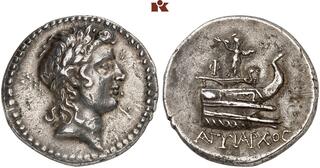| Fritz Rudolf Künker GmbH & Co. KG > Auction 402 | Auction date: 14 March 2024 |
| Lot number: 267 Price realized: 11,000 EUR (Approx. 11,977 USD) Note: Prices do not include buyer's fees. | Show similar lots on CoinArchives Find similar lots in upcoming auctions on |
| Lot description: LYCIA. Prägungen lykischer Städte. PHASELIS AR-Stater, 167/130 v. Chr., Magistrat Agyiarchos; 11,16 g. Apollokopf r. mit Lorbeerkranz//Prora r., darauf Athena r. mit Blitz und Aegis. Heipp-Tamer -; Müseler IX, 23 (dies Exemplar). Feine Tönung, fast vorzüglich Exemplar der Auktion NAC 10, Zürich 1997, Nr. 248. Die bedeutende Hafenstadt Phaselis, malerisch auf einer Halbinsel mit drei Häfen an der Ostküste Lykiens gelegen, gehörte kulturell und sprachlich nicht zu Lykien, wurde später aber zeitweise Mitglied des Lykischen Bundes. Phaselis trug massiv zur Hellenisierung Lykiens bei. Mythisch – vielleicht eine Rückerinnerung an griechische Siedlungsaktionen am Ende der Bronzezeit – soll die Stadt von Mopsos gegründet worden sein (Heropythos von Kolophon in Athenaios VII 297f-298a; Pomponius Mela I 14 [79]), der wahrscheinlich wie in Aspendos vor der Stadtgründung dort einen die Landwirtschaft schädigenden Eber erlegt haben soll. So können die Wildschweine auf den frühen Münzen von Phaselis am besten erklärt werden. Historisch fassbar ist die Gründung der Stadt durch einen gewissen Lakios aus dem rhodischen Lindos. Die Hafenstädte der Insel Rhodos brauchten für den Schiffsbau das Holz Lykiens und gründeten deshalb um die Südostspitze Lykiens mehrere Kolonien. Auf jenen Stateren von Phaselis, die zwischen 167 und 130 v. Chr. geprägt wurden, ist auf der Vorderseite ein lorbeerbekränzter Apollonkopf dargestellt, auf der Rückseite eine blitzeschleudernde Athena, die auf einem Schiffsbug steht. Athena war die Hauptgöttin der Gründerstadt Lindos. Vor Athena ringelt sich drohend eine Schlange. Hinter ihr steht der griechische Buchstabe Φ als Abkürzung für Ph(aseliten)/Φ(ασηλιτ?ν). Athena (Lindia) ist die Hauptgöttin von Phaselis, deren Kult die lindischen Kolonisten einst in die Stadt übertragen hatten. Das Schiff evoziert den Stadtnamen: Phaselis bezeichnet ein schlankes bohnenförmiges Schiff. Athena soll dem Mythos nach von ihrem Vater Zeus beim Kampf gegen die Giganten die Donnerkeile erhalten haben und damit zur Vorkämpferin (Promachos) geworden sein. Das Münzbild ist eine selbstbewusste Machtdemonstration der damals freigewordenen Hafenstadt Phaselis. Dieses Exemplar der Sayar Collection ist, was den Namen des Münzaufsehers angeht, bisher ein Unikum geblieben. Der Name Agyíarchos, d.h. ,Straßenbeherrscher', ist von einem Beinamen des Apollon, Agyieús, abgeleitet und anscheinend nur auf dieser Münze bezeugt (Fehrentz 1993, 148 f.; Köves-Zulauf 1999; Lolos 2005, 163). [JN] The important harbour town of Phaselis, picturesquely situated on a peninsula with three harbours on the east coast of Lycia, did not belong to Lycia culturally or linguistically, but later became a member of the Lycian League for a time. Phaselis contributed massively to the Hellenisation of Lycia. Mythically - perhaps a reminiscence of Greek settlement campaigns at the end of the Bronze Age - the city is said to have been founded by Mopsos (Heropythos of Colophon in Athenaios VII 297f-298a; Pomponius Mela I 14 [79]), who, as in Aspendos before the city was founded, is believed to have killed a boar that was damaging agriculture. This is the best way to explain the wild boars on the early coins of Phaselis. The foundation of the city by a certain Lakios from Rhodian Lindos is historically verifiable. The harbour towns on the island of Rhodes needed Lycian timber for shipbuilding and therefore founded several colonies around the south-eastern tip of Lycia. The staters of Phaselis, which were minted between 167 and 130 BC, depict a laurel-wreathed head of Apollo on the obverse and a lightning-throwing Athena standing on the bow of a ship on the reverse. Athena was the main goddess of the mother city of Lindos. A snake entwines threateningly in front of Athena. Behind her appears the Greek letter Φ as an abbreviation for Ph(aselites)/Φ(ασηλιτ?ν). Athena (Lindia) is the main goddess of Phaselis, whose cult the Lindian colonists had once transferred to the city. The ship evokes the city's name: The word Phaselis refers to a slender bean-shaped ship. According to myth, Athena received the thunderbolts from her father Zeus during the battle against the giants and thus became a champion of the attacked gods (promachos). The coin is a self-confident demonstration of the power of the harbour city of Phaselis, which had become free at that time. This specimen from the Sayar Collection is unique as far as the name of the coin magistrate is concerned. The name Agyíarchos, i.e. 'ruler of the streets', is derived from an epithet of Apollo, Agyieús, and is apparently only attested on this coin (Fehrentz 1993, 148 f.; Köves-Zulauf 1999; Lolos 2005, 163). [JN] Estimate: 1250 EUR |  |



